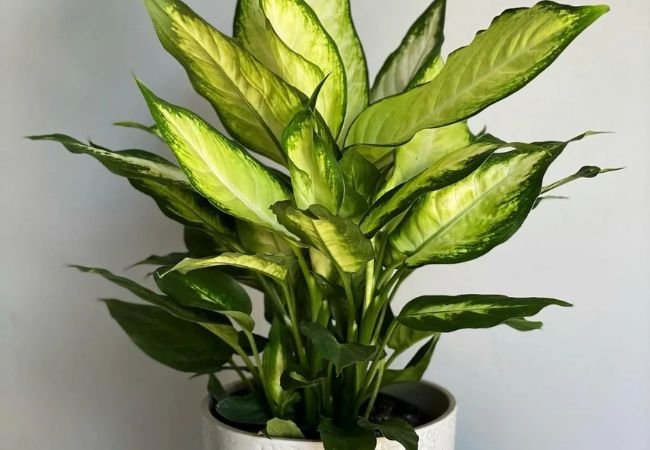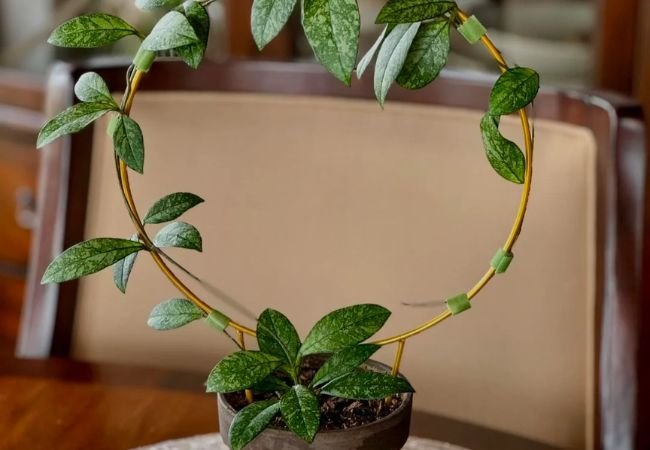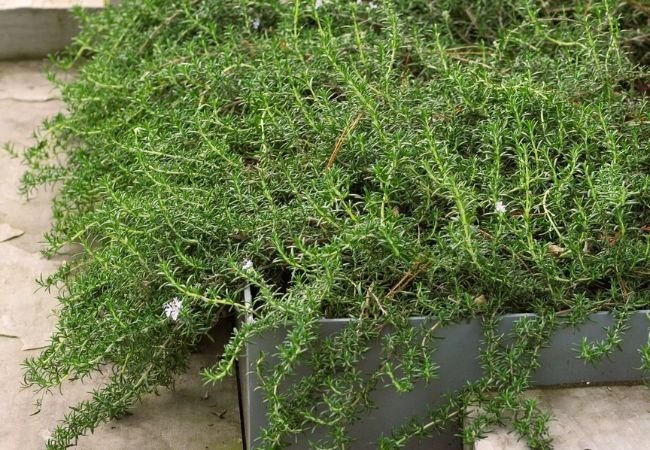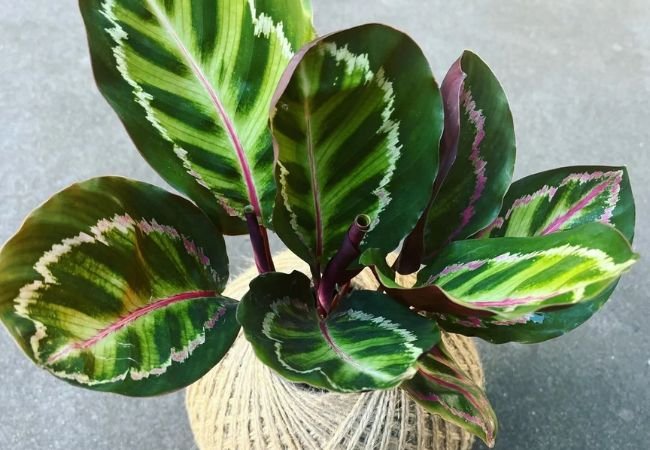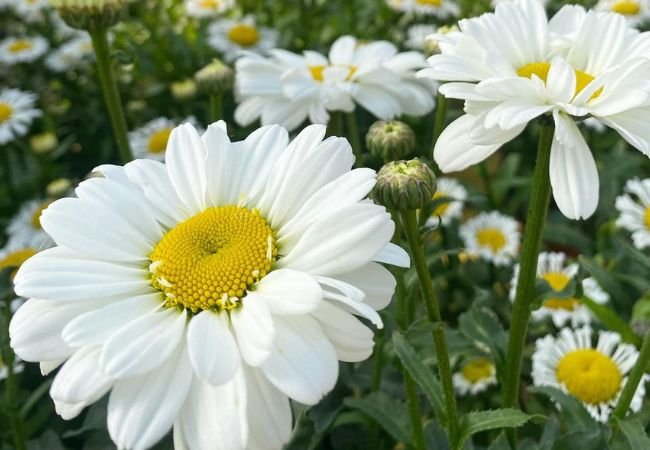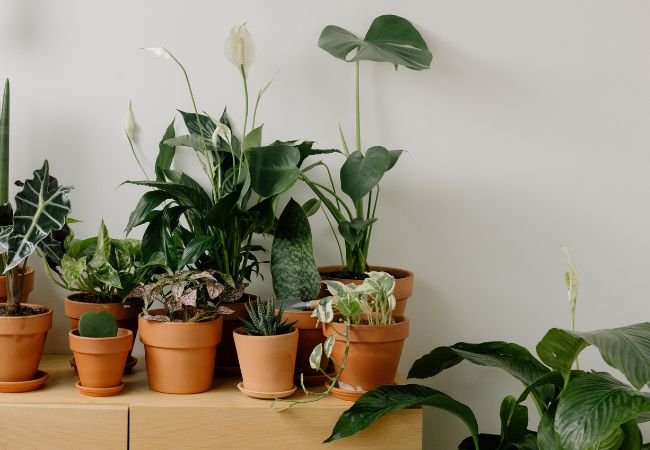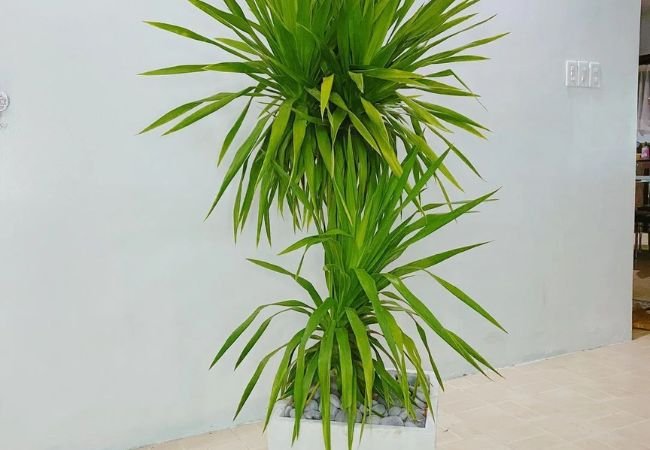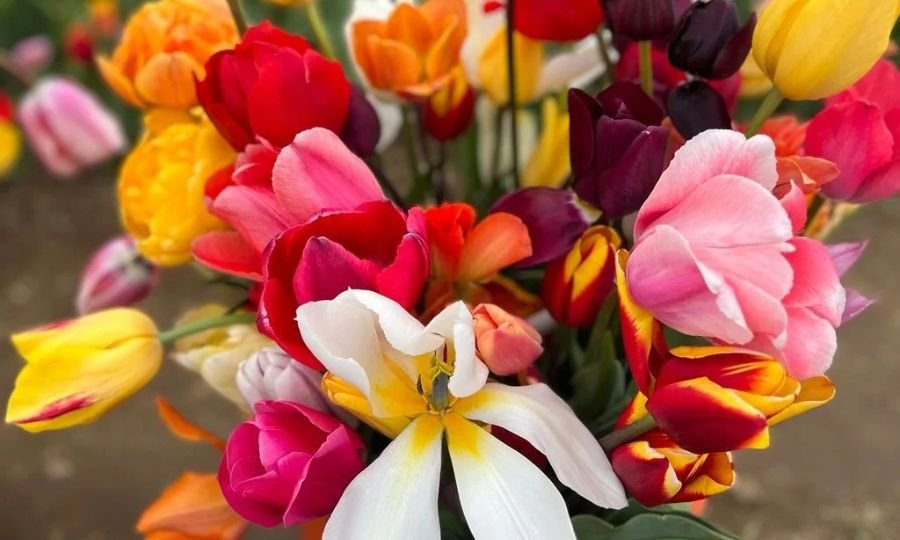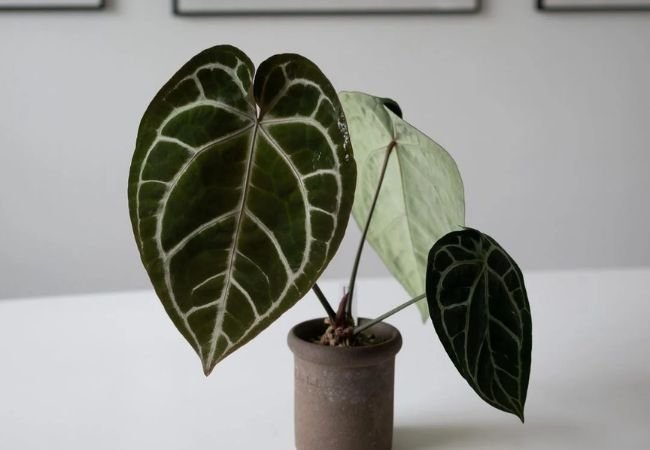Learn how to easily grow and care for dieffenbachia – the beautiful, low-maintenance houseplant with striking patterned leaves. This guide covers planting, ideal conditions and troubleshooting issues.
With their bold leaf patterns and ability to thrive in low light, it’s no wonder dieffenbachia plants are a favorite for adding lush greenery to indoor spaces. These tropicals are not only eye-catching but incredibly easy to care for too!
If you’re looking to brighten up a room with some new plant life, this guide will walk you through everything you need to know about growing healthy, vibrant dieffenbachia. Let’s dig in!
Here’s a short chart with information about Dieffenbachia (Dieffenbachia spp.):
| Aspect | Information |
|---|---|
| Botanical Name | Dieffenbachia spp. |
| Common Names | Dieffenbachia, Dumb Cane, Leopard Lily |
| Plant Type | Perennial, evergreen herbaceous plant |
| Zones | 10-12 (outdoors); can be grown as a houseplant in all zones |
| Exposure | Indirect light, partial shade |
| Bloom Time | Rarely blooms indoors; sporadic flowering in summer outdoors |
| Height/Spread | 2-10 feet tall, 1-3 feet wide |
What is Dieffenbachia?
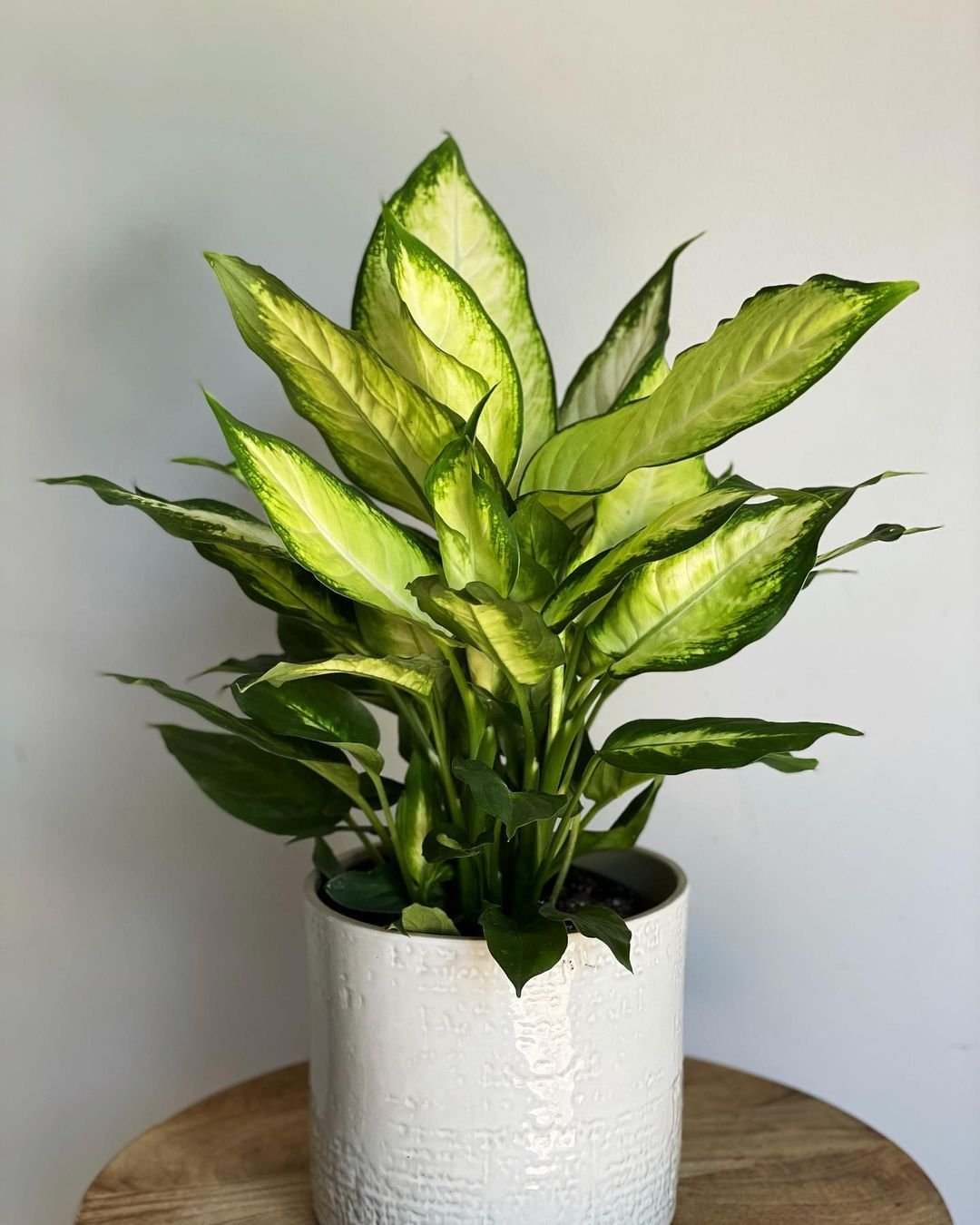
Dieffenbachia is a genus of around 30 different plant species native to the tropical Americas. Thanks to their gorgeous leaves and resilient nature, many varieties are prized as popular houseplants.
The name “dieffenbachia” comes from the German botanist who first described them in the 19th century. But they’re more commonly known as “dumb canes” or “mother-in-law’s tongue” because their sap can irritate the mouth and throat if ingested.
Dieffenbachia have a rhizomatous root structure from which they send up thick, upright stems. Their signature feature is the large, attractive leaves with bold patterns and colors ranging from green, yellow, white and cream.
Some of the most beloved varieties grown indoors include:
- Dieffenbachia seguine (Dumb Cane) – Robust upright stems with large oblanceolate green leaves splotched with white and yellow.
- Dieffenbachia amoena (Tropic Snow) – More compact grower with pointed oval green leaves dappled in white.
- Dieffenbachia maculata (Perfection) – Sturdy yellow stems bearing oblong leaves with green centers and cream outer edges.
- Dieffenbachia bausei (Carina) – Broad leaves with green margins and creamy white or yellow centers separated by a dark green band.
When grown as houseplants, most dieffenbachia will eventually reach a mature height between 2 and 6 feet tall depending on the variety. But they can take several years to get there with proper care.
Where to Grow Dieffenbachia
Like their natural tropical forest habitat, dieffenbachia do best in warm, humid environments with bright, indirect light. They can tolerate some direct sun, especially in the morning, but intense afternoon rays will scorch their leaves.
An east or west-facing room with large windows is ideal for allowing filtered sunlight to reach the plants. Or you can situate them a few feet back from southern exposures. Rotate the pots occasionally to encourage even growth on all sides.
As for temperatures, dieffenbachia plants prefer to stay consistently warm between 65-85°F year-round. They won’t survive long if temps dip below 60°F for extended periods.
The one necessity for a happy dieffenbachia is above-average humidity. Dry indoor conditions can cause the leaves to brown and wilt prematurely. We’ll cover some tips for increasing humidity later on.
Planting Dieffenbachia
Dieffenbachia plants are commonly sold in nursery pots when young. Look for strong, healthy specimens with glossy leaves and firm stems to transplant.
Choose a well-draining potting mix designed for indoor plants. Or create your own by mixing 1 part sterile potting soil with 1 part peat moss or coco coir and 1 part perlite or sand.
For planting, select a pot 2-3 inches wider than the rootball with ample drainage holes in the bottom. It should have enough space for the plant to grow for a year or two before requiring larger quarters.
When potting, dig a hole deep enough so the top of the rootball sits about 1/2 inch below the container rim once backfilled with soil. Settle the plant in place, backfill firmly around the sides and water thoroughly.
Dieffenbachia Care
Beyond their preference for humidity, dieffenbachia plants are generally low-maintenance houseguests when given the proper care. Here’s what they need:
Water
The number one issue with dieffenbachia is overwatering. These tropicals don’t like to sit in soggy soil that can lead to root rot.
Only water your dieffenbachia plant when the top 1-2 inches of soil becomes dry to the touch. Then apply enough to fully saturate the potting mix until the excess drains through the bottom.
In winter when growth slows, you can let the soil dry out a bit more between waterings. Never leave the pot sitting in drained water.
Humidity
Providing sufficient humidity is crucial for healthy dieffenbachia growth. Aim for maintaining at least 40-60% relative humidity around the plants
Some easy ways to increase humidity include grouping plants together, using pebble trays or setting up a small humidifier near your dieffenbachia.
Misting the leaves can help temporarily, but this approach is ineffective at raising overall humidity levels long-term. Be sure to also wipe down the leaves periodically to remove dust.a
Fertilizer
Feed your dieffenbachia monthly during the spring and summer growing season with a balanced, water-soluble fertilizer diluted to half strength. Look for a formula designed for houseplants.
At the onset of winter dormancy in fall, reduce feeding to every 6-8 weeks to allow the plant to rest.
Repotting
Since dieffenbachia have a tendency to become pot-bound, they’ll need repotting every other year in spring once the roots start crowding the container. Gently remove the plant and inspect the rootball. If densely packed with minimal soil remaining, transition to a pot 2 inches wider and replant in fresh potting mix.
Pruning
While not absolutely necessary, pruning can help maintain an attractive, full appearance on your dieffenbachia plant.
Remove any dead, damaged or discolored leaves at the base using clean, sterile pruners. Prune off flower spikes as they appear on potted plants to redirect energy into healthy leaf growth.
To control unruly size or shape, you can judiciously trim back stems by pruning just above a leaf node where new growth will emerge. But avoid heavy pruning in winter.
Propagation
You can easily propagate dieffenbachia by rooting stem cuttings. This allows you to expand your plant collection for free!
Take 4-6 inch cuttings from healthy stems, cutting just below a leaf node. Remove the bottom leaves then dip the cut end in rooting hormone if desired.
Place the cuttings in a cup of water or pot with fresh potting mix. Keep warm and humid until significant root development occurs in 4-8 weeks before transplanting.
Potential Pests & Problems
Dieffenbachia plants are relatively pest and disease-free when given their preferred conditions. But some issues to watch out for include:
- Spider mites – These microscopic pests cause stippling and webbing on leaves. Spray off with water or insecticidal soap.
- Mealybugs, thrips & scale – Use cotton swabs dipped in isopropyl alcohol to wipe off these sap-suckers or spray with insecticidal soap.
- Fungal leaf spots – Prevent by increasing air circulation and not allowing leaves to stay wet. Cut off affected foliage if it persists.
- Root rot – Caused by soggy soil and overwatering. Cut off rotted roots and repot in fresh, well-draining potting mix.
- Leaf curling/browning – Usually a sign of low humidity, underwatering or dry air.
Remember that dieffenbachia are toxic if ingested, so avoid growing them around pets or small children who might nibble the leaves.
With their lush foliage and easygoing nature, dieffenbachia make wonderful additions to brighten up your home! Provide the right warmth, light and humidity and these houseplants will reward you with years of low-maintenance beauty. Let me know if you have any other dieffenbachia questions!

